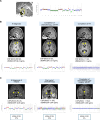High detection rate of circulating-tumor DNA from cerebrospinal fluid of children with central nervous system germ cell tumors
- PMID: 39568077
- PMCID: PMC11580361
- DOI: 10.1186/s40478-024-01886-w
High detection rate of circulating-tumor DNA from cerebrospinal fluid of children with central nervous system germ cell tumors
Abstract
Central nervous system germ cell tumors (CNS-GCT) are malignant neoplasms that arise predominantly during adolescence and young adulthood. These tumors are typically sensitive to treatment, but resulting long-term health deficits are common. Additional clinical challenges include surgical risks associated with tumor biopsy, and need to determine treatment response for adapting radiotherapy protocols. The aim of this study was to establish the detectability of circulating-tumor DNA (ctDNA) from cerebrospinal fluid (CSF) of children with CNS-GCT as a potential biomarker. We obtained CSF from patients with CNS-GCT by lumbar puncture or intra-operatively. Cell-free DNA (cfDNA) was extracted and subjected to low-pass whole genome sequencing (LP-WGS). Copy-number alterations (CNAs) were inferred and served as a marker of measurable residual disease (MRD). Comparisons with imaging findings and tumor marker levels were made. A total of 29 CSF samples from 21 patients (16 with germinoma, 5 with non-germinomatous GCT) were sequenced. Twenty samples from 19 patients were collected at diagnosis, and 9 samples from 7 patients were collected during or after therapy. Among the diagnostic samples, CNAs were detected in samples from 17/19 patients (89%), which included 8 with marker-negative tumors. Specific clinical scenarios suggested that serial cfDNA analysis may carry utility in tracking treatment responses as well as clarifying indeterminate imaging findings. Our results provide evidence for the high-sensitivity in detecting ctDNA from CSF of CNS-GCT patients using LP-WGS, with potential utility for non-invasive diagnosis and disease monitoring in upcoming CNS-GCT studies.
Keywords: Cell-free DNA; Central nervous system germ cell tumors; Circulating-tumor DNA; Liquid biopsies; Measurable residual disease.
© 2024. The Author(s).
Conflict of interest statement
Declarations. Ethics approval and consent to participate: This study was approved by the Hospital for Sick Children Research Ethical Board (REB # 1000071241) and the Hong Kong Children’s Hospital Research Ethics Committee (HKCH-REC-2020-068). Written informed consent was obtained from all patients, their parents or guardians. Consent for publication: Written informed consent for the publication was obtained from all patients participants, their parents or guardians. Competing interests: The authors declare no competing interests.
Figures


Similar articles
-
Ultra-low-input cell-free DNA sequencing for tumor detection and characterization in a real-world pediatric brain tumor cohort.Acta Neuropathol Commun. 2025 Jun 28;13(1):134. doi: 10.1186/s40478-025-02024-w. Acta Neuropathol Commun. 2025. PMID: 40579709 Free PMC article.
-
Detection of H3F3A K27M or BRAF V600E in liquid biopsies of brain tumor patients as diagnostic and monitoring biomarker: impact of tumor localization and sampling method.Acta Neuropathol. 2025 Jan 3;149(1):5. doi: 10.1007/s00401-024-02842-7. Acta Neuropathol. 2025. PMID: 39751690 Free PMC article.
-
Detection of diagnostic somatic copy number alterations from cerebrospinal fluid cell-free DNA in brain tumor patients.Acta Neuropathol Commun. 2024 Nov 20;12(1):177. doi: 10.1186/s40478-024-01887-9. Acta Neuropathol Commun. 2024. PMID: 39568088 Free PMC article.
-
CSF tau and the CSF tau/ABeta ratio for the diagnosis of Alzheimer's disease dementia and other dementias in people with mild cognitive impairment (MCI).Cochrane Database Syst Rev. 2017 Mar 22;3(3):CD010803. doi: 10.1002/14651858.CD010803.pub2. Cochrane Database Syst Rev. 2017. PMID: 28328043 Free PMC article.
-
Blood and cerebrospinal fluid biomarkers in neuro-oncology.Curr Opin Neurol. 2024 Dec 1;37(6):693-701. doi: 10.1097/WCO.0000000000001317. Epub 2024 Sep 27. Curr Opin Neurol. 2024. PMID: 39329301 Review.
References
-
- Mori K, Kurisaka M (1986) Brain tumors in childhood: statistical analysis of cases from the Brain Tumor Registry of Japan. Childs Nerv Syst 2:233–237 - PubMed
-
- Balmaceda C, Heller G, Rosenblum M, Diez B, Villablanca JG, Kellie S et al (1996) Chemotherapy without irradiation–a novel approach for newly diagnosed CNS germ cell tumors: results of an international cooperative trial. The First International Central Nervous System Germ Cell Tumor Study. J Clin Oncol 14:2908–15 - PubMed
Publication types
MeSH terms
Substances
Grants and funding
LinkOut - more resources
Full Text Sources

